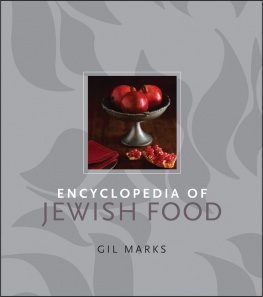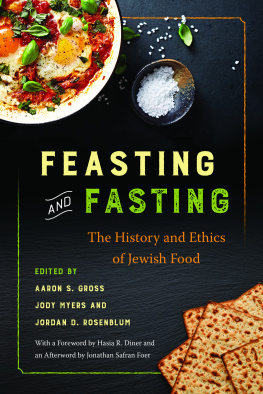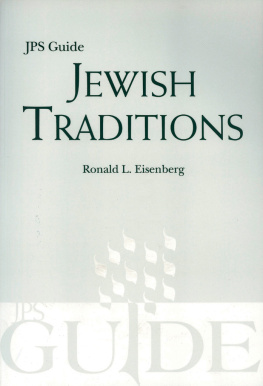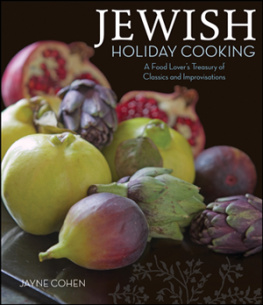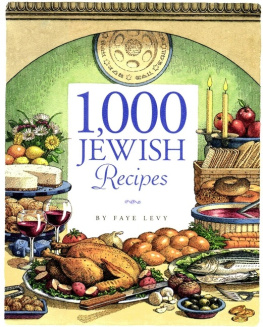Marks - Encyclopedia of Jewish Food
Here you can read online Marks - Encyclopedia of Jewish Food full text of the book (entire story) in english for free. Download pdf and epub, get meaning, cover and reviews about this ebook. City: Chichester, year: 2010, publisher: Houghton Mifflin Harcourt;John Wiley & Sons, genre: Home and family. Description of the work, (preface) as well as reviews are available. Best literature library LitArk.com created for fans of good reading and offers a wide selection of genres:
Romance novel
Science fiction
Adventure
Detective
Science
History
Home and family
Prose
Art
Politics
Computer
Non-fiction
Religion
Business
Children
Humor
Choose a favorite category and find really read worthwhile books. Enjoy immersion in the world of imagination, feel the emotions of the characters or learn something new for yourself, make an fascinating discovery.
- Book:Encyclopedia of Jewish Food
- Author:
- Publisher:Houghton Mifflin Harcourt;John Wiley & Sons
- Genre:
- Year:2010
- City:Chichester
- Rating:4 / 5
- Favourites:Add to favourites
- Your mark:
Encyclopedia of Jewish Food: summary, description and annotation
We offer to read an annotation, description, summary or preface (depends on what the author of the book "Encyclopedia of Jewish Food" wrote himself). If you haven't found the necessary information about the book — write in the comments, we will try to find it.
Food is more than just sustenance. Its a reflection of a communitys history, culture, and values. From India to Israel to the United States and everywhere in between, Jewish food appears in many different forms and variations, but all related in its fulfillment of kosher laws, Jewish rituals, and holiday traditions. The Encyclopedia of Jewish Food explores both unique cultural culinary traditions as well as those that unite the Jewish people.
- Alphabetical entriesfrom Afikomen and Almond to Yom Kippur and Zaatarcover ingredients, dishes, holidays, and food traditions that are significant to Jewish communities around the world
- This easy-to-use reference includes more than 650 entries, 300 recipes, plus illustrations and maps throughout
- Both a comprehensive resource and fascinating reading, this book is perfect for Jewish cooks, food enthusiasts, historians, and anyone interested in Jewish history or food
The Encyclopedia of Jewish Food is an informative and eye-opening guide to the culinary heart and soul of the Jewish people.
Recipe Excerpt: Sufganiyot (Israeli Jelly Donuts)
The first record of filling a fried piece of dough with jelly was in Germany in 1485. Within a century, jelly doughnuts reached Poland, where Jews called them ponchiks (from the Polish word for flower bud), and in some areas they became a popular Hanukkah treat, filled with plum, raspberry, or rose petal jam. In the late 1800s, Polish immigrants brought the ponchik to Israel, where it eventually took the Hebrew name sufganiyah (sufganiyot--plural), from a spongy dough mentioned in the Talmud. At first, jelly doughnuts were not widely eaten in Israel, even on Hanukkah, as they were difficult and intimidating for many people to make. Only a few homes and bakeries continued to prepare them. Then in the late 1920s, the Israeli labor federation championed sufganiyot as a Hanukkah treat because they provided work - preparing, transporting, and selling the doughnuts -- for its members. Sufganiyot soon emerged as by far the most popular Israeli Hanukkah food, filled not only with jelly but also dulce de leche, halva, crme espresso, chocolate truffle, and numerous exotic flavors.
These jelly doughnuts are irresistible. The trick to making non-greasy, fully-cooked doughnuts is working with the temperature of the oil. If the oil is not hot enough, the dough will absorb oil; if it is too hot, the outsides of the dough will brown before the insides have cooked. To test the temperature of the oil, use a candy thermometer or drop a cube of soft white bread in the oil; it should brown in 35 seconds. A traditional sign of proper cooking is a light-colored ring around the center of the doughnut, indicative that the fat was hot enough to push the doughnut to the surface before browning too much of the dough. A typical 3-inch jelly-doughnut is made from cup (2 ounces) dough and contains tablespoon (1 ounce) of jelly.
Recipe
Makes about 16 medium doughnuts
Ingredients
1 (-ounce) package (2 teaspoons) active dry yeast or 1 (0.6-ounce) cake fresh yeast
cup warm water (105 to 110 degrees for dry yeast; 80 to 85 degrees for fresh yeast)
cup sugar or vanilla sugar
cup milk, soy milk, or water
6 tablespoons vegetable oil, vegetable shortening, or softened butter
3 large eggs (or 2 egg yolks and 1 large egg)
1 teaspoon table salt or 2 teaspoons kosher salt
teaspoon ground nutmeg or mace, 1 teaspoon grated lemon zest, teaspoon lemon extract, or 1 teaspoons ground cinnamon (optional)
About 3 cups (18 ounces) bread or unbleached all-purpose flour
About 5 cups vegetable oil, safflower oil, sunflower oil, peanut oil, or vegetable shortening for deep-frying
About 1 cup jelly or pastry cream
Confectioners or sugar for dusting
Directions
1. To make the dough: Dissolve the yeast in the water. Stir in 1 teaspoon sugar and let stand until foamy, 5 to 10 minutes. Blend in the milk, remaining sugar, oil, eggs, salt, optional nutmeg, and 2 cups flour. Gradually beat in enough of the remaining flour to make a smooth, soft dough. Cover and let rise until double in bulk, about 1 hours.
2. Punch down the dough. Fold over and press together several times. Let stand for 15 minutes. Roll out the dough inch thick. Cut out 2- to 3-inch rounds. Place in a single layer on a lightly floured surface, cover, and let rise until double in bulk, about 1 hour.
3. In a large deep pot, heat at least 2 inches of oil over medium heat to 375 degrees.
4. Using an oiled spatula, carefully lift the doughnuts and drop them, top side down, into the oil. If you drop them bottom side down, the doughnuts are difficult to turn and do not puff up as well. The temperature of the oil should not drop below 350 degrees. Fry 3 or 4 at a time without crowding the pan, turning once, until golden brown on all sides, about 1 minutes per side. Remove with a wire mesh skimmer or tongs and drain on a wire rack.
5. Place some of the jelly in a cookie press, pastry syringe, or a pastry bag fitted with a -inch hole or nozzle tip. Insert the tip into a side of a doughnut and gently fill with about 1 tablespoon jelly. Roll the doughnuts in the sugar. The fresher the doughnut, the better the flavor and texture.
Variations: To make doughnuts without a cookie press or pastry bag: Place 1 teaspoon of jelly in the center of half of the unrisen dough rounds. Brush the edges with egg white, saving a white from the eggs used to make the dough. Top with a second dough round and press the edges to seal.
Additional Recipe Excerpts:
Borscht--a soup made with beets
Foulare/Folar--a sweet pastry enwrapping a hard- boiled egg or a Sephardic long-cooked egg
Kouclas--a dumpling cooked in Sabbath stews
Marks: author's other books
Who wrote Encyclopedia of Jewish Food? Find out the surname, the name of the author of the book and a list of all author's works by series.

